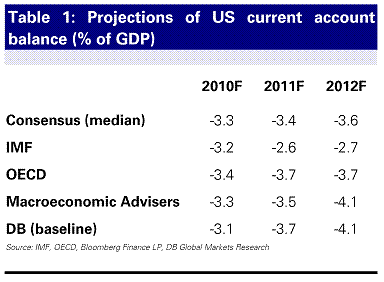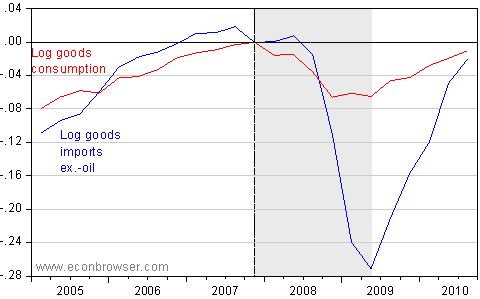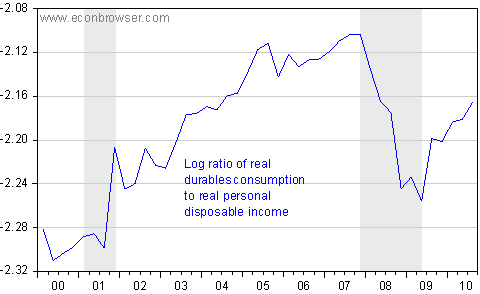Most forecasts incorporate a resurgence in the US trade and current account deficits. This projection makes sense to the extent that the US is expected to grow faster than Europe and Japan, and the estimated income elasticity of US imports exceeds that of US exports (the Houthakker-Magee finding [0]). Here’s a summary of forecasts for the current account.

Source: Peter Hooper and Torsten Slok, “US external deficit likely to widen further ahead,” Global Economic Perspectives (Deutsche Bank, Dec. 8, 2010). [not online]
The only forecast that indicates a CA deficit reduction is the IMF’s. (The Fed’s forecasting framework has similar predictions [1], [paper]) What would alter the basic thrust of these projections? Changes in the assumed income growth rate and value of the US dollar would obviously have an impact. But higher price elasticities (as discussed here), or a reduction in the income elasticity asymmetry could also imply a different path for the external accounts. With regard to the latter, a change in the behavior of consumers with respect to imported goods (see previous discussion here).
So, while total real consumption has almost returned to its pre-recession peak in 2007Q4 (per capita is still below), total consumption of goods has not (it’s about 1% below peak).

Figure 1: Log consumption (blue, left scale), and log durables and nondurables goods consumption (red, right scale). NBER defined recession dates shaded gray. Source: BEA, 2010Q3 GDP 3rd release, NBER, and author’s calculations.
By the way, some observers have in the past wondered where the consumption disaster was. [3] [4] At its trough in 2009Q2, per capita consumption was 3.7% lower than peak in 2007Q4 (log terms). The deviation relative to 2000Q1-07Q4 trend would be much larger — 7.5% in 2009Q2, and 8.6% as of 2010Q3
To the extent that durables and nondurables consumption remains low, goods imports will tend to be lower than pre-recession trend levels.

Figure 2: Log goods imports ex.-oil (blue), and log durables and nondurables goods consumption (red), rescaled to 2007Q4=0. NBER defined recession dates shaded gray. Source: BEA, 2010Q3 GDP 3rd release, NBER, and author’s calculations.
Consumption should be lower because of deleveraging, as households attempt to rebuild their balance sheets. [5] [Glick/Lansing] But in addition, if credit is going to be harder to obtain going forward (at least harder to obtain than pre-2007), then one should expect the stock of consumer durables (as a ratio of income) to be lower.

Figure 3: Log ratio of real durables consumption to real personal disposable income (deflated by PCE deflator). NBER defined recession dates shaded gray. Source: BEA, 2010Q3 GDP 3rd release, NBER, and author’s calculations.
Of course, it’s possible that Americans will resume their spendthrift ways, in which case, the CA deficit will surely widen.
For more on prospects for US exports (as well as imports), see this post.
With the benefit of insight and everything remaining the same, no restriction on hot money inflows or outflows,forecast are welcome.
Alan Greenspan :current account Economic club of New York 2 March 2004
http://www.bis.org/review/r040305b.pdf
“For the United States studies have shown that individual investors and even professional managers have a slight preference in their own communities and states.
As a consequence home bias will likely to constraint the movement of world savings into optimum use as capital investment,thus limiting the internationalization and hence the growth of international assets and liabilities and the dispersion of world current account that such growth implies.”
For information
U.S. Private Direct Investment Abroad
http://research.stlouisfed.org/fred2/series/BOPOPDN
“Evidence on Financial globalization and crisis Global imbalances M Chinn” chart P5,
Looking at the bop of the euro area,swings are noticeable in 2009,but nothing that could not be explained (either by the total collapse of the international trade? or by the hot money capital outflows)
Euro Area Balance of Payments and International Investment Position Statistics
http://sdw.ecb.europa.eu/browseChart.do?sk=116.BOP.M.U2.N.4.010.N.A1.E&node=SEARCHRESULTS&q=current+account&trans=N
“Of course, it’s possible that Americans will resume their spendthrift ways, in which case, the CA deficit will surely widen.”
It can’t be this simple, can it? It all depends on what Americans save money on, and what they still buy. If they all buy less, but keep the same mix of US-made and foreign-made products, the CA goes down in absolute terms. If Americans decide to buy relatively more US-made than foreign-made goods, this will be even more pronounced. Only if it is assumed that being spendthrift equals buying foreign products in stead of buying domestic, you can make a case that just being spendthrift increases the CA.
Impact of oil prices at $90-100?
Menzie wrote:
Consumption should be lower because of deleveraging, as households attempt to rebuild their balance sheets. [5] [Glick/Lansing] But in addition, if credit is going to be harder to obtain going forward (at least harder to obtain than pre-2007), then one should expect the stock of consumer durables (as a ratio of income) to be lower.
Menzie,
This is one of the most perceptive things you have written in a while. Now if you can expand your understanding of the deleveraging to more of the economy (such as the impact on excess bank reserves. See JDH’s post) many more things will begin to come into focus.
These forecast mean that US foreign borrowing will be some 3% to 4% of GDP as compared to 6% and rising at the last cyclical peak.
So the reduced US dependence on foreign borrowing should continue for another year or two as both personal savings and business savings will be a larger share of gdp than at the last cyclical peak.
Does this imply that the role of the Euro, Yen, etc as alternative reserve currencies will grow in importance over the next few years? this is a question, not a statement.
endorendil: Yes, what you say is true, but I assumed that as a given, since I’d blogged so much about expenditure switching in the past. The domestic/foreign produced mix should change given depreciated dollar relative to two years ago; in addition, I was thinking of decreased consumption levels on top further driving down imports relative to trend.
Steve Kopits: Clearly, higher oil prices reduces the nominal trade balance/GDP ratio. I was focusing on real non-oil magnitudes here, to take out the oii component.
spencer: In my econometric work, I never found a role for surpluses as a determinant of reserve currency roles, at least over short horizons. I think macro volatility conditions and financial openness dominate (see here).
Merry Christmas to you Menzie, and also to Jim (and the regulars, too)
Rich Berger: Thank you! And a peace and joy to you and yours, and the entire Econbrowser community.